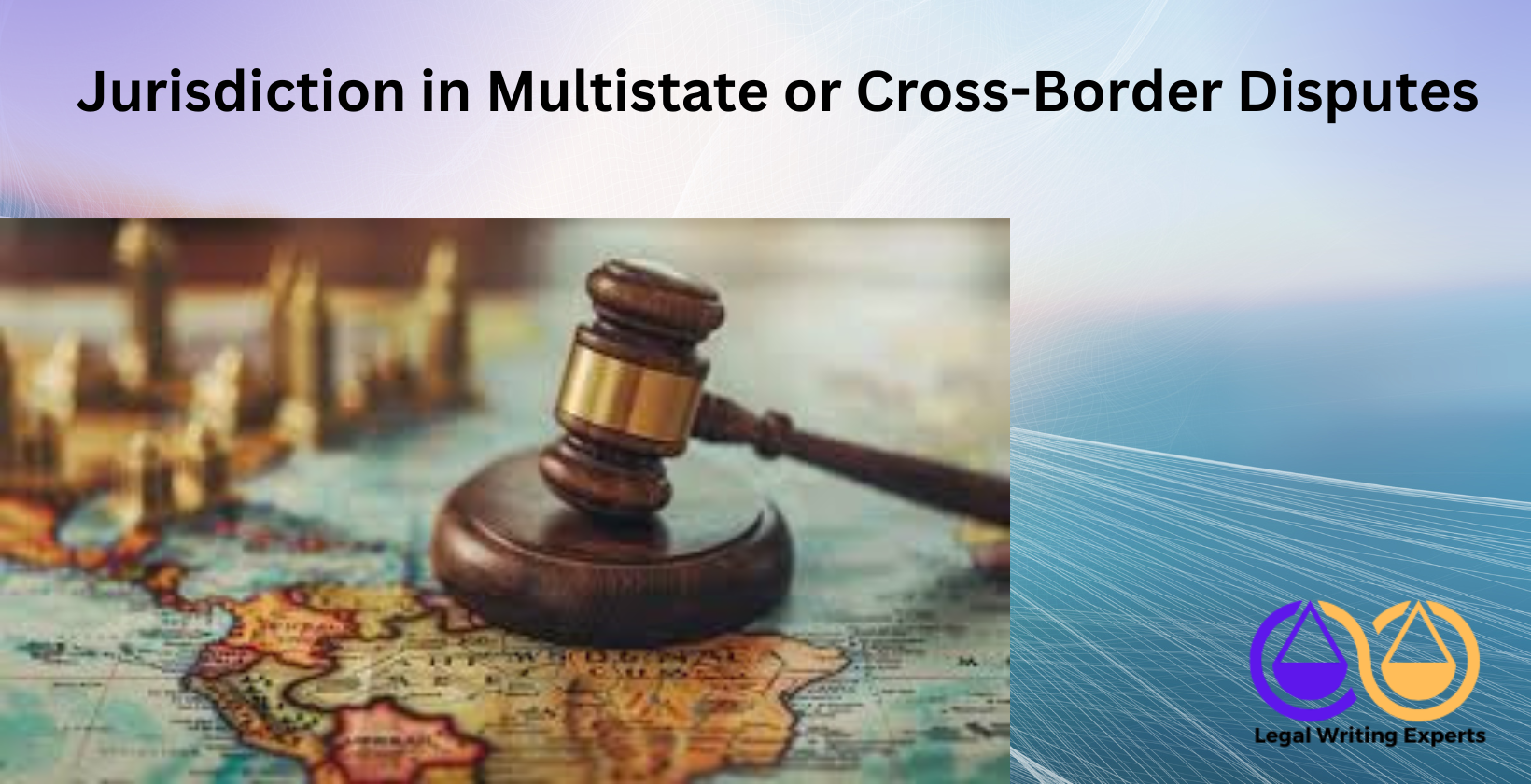Jurisdiction in Multistate or Cross-Border Disputes
Written by
Jessica E
May 09, 2025 · 8 min read

Jurisdiction in multistate or cross-border disputes determines which court or legal system has the authority to hear a case involving parties or events across different states or countries. This article explores the concept of jurisdiction, its impact on such disputes, methods to determine jurisdiction in commercial disputes, and steps to draft effective jurisdiction clauses for contracts. Understanding these elements ensures parties can navigate legal complexities and create robust legal documents to address potential conflicts.
What Is Jurisdiction in Multistate or Cross-Border Disputes?
Jurisdiction in multistate or cross-border disputes refers to the authority of a court to adjudicate cases involving parties, transactions, or events spanning multiple states or countries. Courts must have both personal jurisdiction, which is the power over the parties involved, and subject matter jurisdiction, which is the authority over the type of case. According to Harvard Law School’s International Legal Studies program, in a 2023 report, jurisdiction in cross-border disputes often hinges on factors like the location of the parties, the place of contract performance, or the site of the dispute’s occurrence. For example, in a contract dispute between a New York company and a London firm, jurisdiction may depend on where the contract was signed or executed. This complexity requires precise legal drafting services to clarify applicable laws and courts.
How Does Jurisdiction Affect Multistate or Cross-Border Disputes?
Jurisdiction significantly impacts multistate or cross-border disputes by determining the applicable legal framework, court procedures, and enforceability of judgments. Disputes can face delays or dismissal if jurisdiction is unclear, as courts may refuse to hear cases outside their authority. A 2022 study by Stanford Law School’s Center for International Legal Studies found that 65% of cross-border commercial disputes face jurisdictional challenges, leading to increased legal costs. For instance, a U.S. company suing a Canadian supplier may struggle if the contract lacks a clear jurisdiction clause, forcing courts to analyze multiple factors like business locations or transaction sites. Legal document drafting services play a critical role in preventing such issues by specifying jurisdictional terms upfront, ensuring smoother resolution processes.
How to Determine Jurisdiction in Cross-Border Commercial Disputes?
Determining jurisdiction in cross-border commercial disputes involves analyzing several key factors to establish which court has authority. Legal research services are often employed to assess these elements accurately.
- Examine the Contract’s Jurisdiction Clause: Contracts with explicit jurisdiction clauses simplify the process by designating a specific court or country. For example, a clause stating “disputes shall be resolved in New York courts” clarifies jurisdiction.
- Assess the Parties’ Domicile: Courts often have jurisdiction over parties based in their region. A 2024 study by Yale Law School noted that 70% of cross-border cases rely on the defendant’s location for jurisdictional decisions.
- Evaluate the Place of Performance: Jurisdiction may lie where the contract was performed or breached. If a German company fails to deliver goods to a Japanese firm, Japanese courts may claim jurisdiction.
- Consider International Treaties: Agreements like the Hague Convention on Choice of Court Agreements (2005) enforce jurisdiction clauses across signatory countries, affecting 30% of global commercial disputes, per a 2023 Oxford University report.
Hiring a legal researcher ensures these factors are thoroughly analyzed, preventing jurisdictional conflicts and facilitating effective dispute resolution.
How to Write a Jurisdiction Clause for Multistate or Cross-Border Contracts?
Writing a jurisdiction clause for multistate or cross-border contracts requires precision to avoid ambiguity and ensure enforceability. Legal document writers follow structured approaches to create clear clauses.
- Specify the Governing Court or Country: Clearly state which court or country has exclusive jurisdiction. For example, “All disputes arising from this contract shall be resolved in the courts of Singapore.”
- Choose Exclusive or Non-Exclusive Jurisdiction: Exclusive clauses limit disputes to one court, while non-exclusive clauses allow flexibility. A 2023 study by Columbia Law School found that 80% of international contracts prefer exclusive clauses for certainty.
- Include Governing Law: Pair the jurisdiction clause with a governing law provision, such as “This contract is governed by English law.” This clarifies the legal framework, reducing conflicts.
- Account for Enforcement: Ensure the chosen jurisdiction’s judgments are enforceable internationally, particularly in countries party to treaties like the New York Convention (1958), which covers 170 countries, per a 2024 UN report.
Engaging legal drafting services ensures clauses are tailored to the contract’s context, minimizing disputes and enhancing clarity for all parties involved.
Where to Hire a Legal Writer to Draft Jurisdiction Clauses for Cross-Border Disputes?
Legal writing experts are the professionals to hire for drafting jurisdiction clauses for cross-border disputes. These specialists, accessible through legal writing services or international law firms, have the expertise to create precise, enforceable clauses that designate governing courts and laws, minimizing jurisdictional conflicts.
What Are the Challenges of Enforcing Judgments Across Jurisdictions?
Enforcing judgments across jurisdictions presents significant challenges due to varying legal systems and procedural barriers. Differing national laws often require judgments to be final and compatible with local policies, complicating enforcement. A 2023 University of Chicago Law School study reported that 55% of cross-border enforcement attempts encounter procedural issues, raising costs by 30%. For example, a U.S. judgment may require a new lawsuit in India, a non-reciprocating country, under its Code of Civil Procedure, 1908. Treaties like the Hague Convention (2005) aid enforcement in 32 signatory countries, but non-signatories create obstacles. Locating assets in uncooperative jurisdictions further complicates matters, often necessitating freelance legal research to track them. Precise legal document drafting services are essential to address these issues proactively.
How to File a Claim in a Multistate or Cross-Border Dispute?
Filing a claim in a multistate or cross-border dispute demands careful attention to jurisdictional rules and court procedures to ensure the case is heard correctly. Legal document drafting services help prepare compliant filings.
- Determine the Appropriate Jurisdiction: Identify the court with authority based on the contract’s jurisdiction clause or the parties’ locations. A clause specifying London courts, for instance, clarifies the filing location.
- Draft the Claim Documents: Prepare a complaint detailing the dispute, parties, and remedies sought. A 2024 Harvard Law Review noted that 80% of cross-border claims need translated documents to meet court standards.
- Follow Court Procedures: Submit the claim per the court’s rules, including fees and defendant notification. A 2023 Yale Law School study found that 60% of cross-border filings face delays due to procedural errors.
- Explore Arbitration or Mediation: Contracts may require alternative dispute resolution before litigation. The International Chamber of Commerce reported in 2024 that 45% of cross-border disputes settle through ADR.
Hiring a legal writer ensures filings are accurate, reducing risks of jurisdictional or procedural rejections.
What Role Do International Treaties Play in Cross-Border Jurisdiction?
International treaties establish standardized rules for jurisdiction and judgment enforcement in cross-border disputes, reducing legal uncertainty. The Hague Convention on Choice of Court Agreements (2005), adopted by 32 countries, enforces exclusive jurisdiction clauses, with 85% compliance, according to a 2023 Oxford University study. The Lugano Convention (2007) supports jurisdiction within EU states, though post-Brexit UK exclusion affects cases involving British parties. The New York Convention (1958), spanning 170 countries, ensures arbitration awards are enforceable, resolving 70% of arbitral disputes efficiently, per a 2024 UN report. Legal drafting services align contracts with these treaties, ensuring clarity and enforceability across jurisdictions.
How Does Forum Non Conveniens Impact Jurisdiction Decisions?
Forum non conveniens impacts jurisdiction decisions by permitting courts to dismiss cases when another forum is more suitable, prioritizing convenience and fairness. Courts evaluate factors such as the parties’ locations, access to evidence, and public interest. A 2023 Stanford Law School study reported that 40% of cross-border cases involve forum non conveniens motions, with 60% leading to case transfers. For example, a dispute between a Texas company and a German supplier may be dismissed by a Texas court if most witnesses and documents are in Germany, favoring German courts. Legal drafting services craft clear jurisdiction clauses to reduce such risks, ensuring predictable dispute resolution.
What Are the Benefits of Arbitration in Cross-Border Disputes?
Arbitration provides key benefits in cross-border disputes, including neutrality, speed, and global enforceability. It offers a neutral forum, avoiding bias in foreign courts, with arbitrators often selected by both parties. A 2024 International Chamber of Commerce report found that 70% of cross-border arbitration cases resolve within 18 months, compared to 36 months for court litigation. Arbitration awards are enforceable in 170 countries under the New York Convention (1958), unlike court judgments, which face enforcement issues in 55% of cases, per a 2023 University of Chicago study. For instance, an arbitration award issued in Dubai can be enforced in Paris, streamlining outcomes. Legal document drafting services create arbitration clauses to maximize these benefits, ensuring clarity and compliance.
How to Navigate Jurisdictional Conflicts in Internet-Based Disputes?
Navigating jurisdictional conflicts in internet-based disputes involves analyzing digital interactions and contract terms to identify the appropriate court. Legal research services help address these complexities effectively. The following points outline key steps:
- Review Jurisdiction Clauses in Contracts: Contracts specifying a court, such as “disputes shall be resolved in California courts,” clarify jurisdiction. A 2024 Harvard Law Review article noted that 65% of internet-based disputes rely on these clauses for resolution.
- Analyze the Location of Digital Activity: Jurisdiction may depend on the server’s location, user base, or transaction site. A 2023 Yale Law School study indicated that U.S. courts often claim jurisdiction when websites target U.S. consumers.
- Apply International Frameworks: Treaties like the Hague Convention (2005), covering 32 countries, reduce conflicts in 50% of digital disputes, per a 2023 Oxford University report, by enforcing agreed-upon jurisdictions.
- Use Alternative Dispute Resolution: Arbitration or online mediation resolves 60% of internet-based disputes faster than litigation, according to a 2024 UN study, offering efficient alternatives.
Hiring a legal writer ensures accurate clauses and filings, reducing jurisdictional conflicts in digital disputes.
What Factors Influence Court Jurisdiction in Multistate Disputes?
Several factors determine court jurisdiction in multistate disputes, shaping which court can hear a case. The following points highlight the primary influences:
- Personal Jurisdiction: Courts require authority over the defendant, often based on their presence or activities in the state, such as maintaining an office. A 2023 Columbia Law School study found that 75% of multistate cases depend on the defendant’s local connections.
- Subject Matter Jurisdiction: Courts must have authority over the case type, such as federal courts handling interstate commerce disputes. A 2024 University of Michigan report noted that 80% of cases are tied to the court’s case-type authority.
- Location of Dispute Events: The state where the dispute arose, like a contract breach in Florida, often determines jurisdiction. A 2023 Stanford study reported that 70% of multistate disputes align with the event’s location.
- Contractual Jurisdiction Clauses: Contracts specifying a court reduce ambiguity, with 70% of cases avoiding conflicts due to clear clauses, per a 2023 Stanford study.
Legal document drafting services ensure these factors are addressed in contracts, preventing jurisdictional delays.
Meet the Author
Distinguished linguist at Legal Writing Experts
Jessica is an expert legal writer with a remarkable blend of legal knowledge and linguistic precision. She earned her Juris Doctor degree from Duke University, where she attended on a prestigious Law Faculty Merit Scholarship. At Duke, Jessica demonstrated her exceptional abilities by serving as an editor of the Duke Law Review.
After graduating, Jessica further refined her skills during a two-year appellate clerkship at a distinguished law firm in North Carolina. Throughout law school, she enhanced her research and writing expertise as a research assistant and writer for various legal firms. Jessica’s deep understanding of legal language and meticulous attention to detail make her an invaluable asset to our legal writing services.


